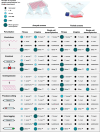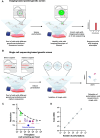Next generation genetic screens in kinetoplastids
- PMID: 40530689
- PMCID: PMC12203798
- DOI: 10.1093/nar/gkaf515
Next generation genetic screens in kinetoplastids
Abstract
The genomes of all organisms encode diverse functional elements, including thousands of genes and essential noncoding regions for gene regulation and genome organization. Systematic perturbation of these elements is crucial to understanding their roles and how their disruption impacts cellular function. Genetic perturbation approaches, which disrupt gene expression or function, provide valuable insights by linking genetic changes to observable phenotypes. However, perturbing individual genomic elements one at a time is impractical. Genetic screens overcome this limitation by enabling the simultaneous perturbation of numerous genomic elements within a single experiment. Traditionally, these screens relied on simple, high-throughput readouts such as cell fitness, differentiation, or one-dimensional fluorescence. However, recent advancements have introduced powerful technologies that combine genetic screens with image-based and single-cell sequencing readouts, allowing researchers to study how perturbations affect complex cellular phenotypes on a genome-wide scale. These innovations, alongside the development of CRISPR-Cas technologies, have significantly enhanced the precision, efficiency, and scalability of genetic screening approaches. In this review, we discuss the genetic screens performed in kinetoplastid parasites to date, emphasizing their application to both coding and noncoding regions of the genome. Furthermore, we explore how integrating image-based and single-cell sequencing technologies with genetic screens holds the potential to deliver unprecedented insights into cellular function and regulatory mechanisms.
© The Author(s) 2025. Published by Oxford University Press on behalf of Nucleic Acids Research.
Conflict of interest statement
No conflicts of interest declared.
Figures





Similar articles
-
Systemic pharmacological treatments for chronic plaque psoriasis: a network meta-analysis.Cochrane Database Syst Rev. 2021 Apr 19;4(4):CD011535. doi: 10.1002/14651858.CD011535.pub4. Cochrane Database Syst Rev. 2021. Update in: Cochrane Database Syst Rev. 2022 May 23;5:CD011535. doi: 10.1002/14651858.CD011535.pub5. PMID: 33871055 Free PMC article. Updated.
-
How to Implement Digital Clinical Consultations in UK Maternity Care: the ARM@DA Realist Review.Health Soc Care Deliv Res. 2025 May;13(22):1-77. doi: 10.3310/WQFV7425. Health Soc Care Deliv Res. 2025. PMID: 40417997 Review.
-
Systemic pharmacological treatments for chronic plaque psoriasis: a network meta-analysis.Cochrane Database Syst Rev. 2017 Dec 22;12(12):CD011535. doi: 10.1002/14651858.CD011535.pub2. Cochrane Database Syst Rev. 2017. Update in: Cochrane Database Syst Rev. 2020 Jan 9;1:CD011535. doi: 10.1002/14651858.CD011535.pub3. PMID: 29271481 Free PMC article. Updated.
-
Psychological interventions for adults who have sexually offended or are at risk of offending.Cochrane Database Syst Rev. 2012 Dec 12;12(12):CD007507. doi: 10.1002/14651858.CD007507.pub2. Cochrane Database Syst Rev. 2012. PMID: 23235646 Free PMC article.
-
Deep Genomics: Deep Learning-Based Analysis of Genome-Sequenced Data for Identification of Gene Alterations.Methods Mol Biol. 2025;2952:335-367. doi: 10.1007/978-1-0716-4690-8_20. Methods Mol Biol. 2025. PMID: 40553343
References
Publication types
MeSH terms
Grants and funding
LinkOut - more resources
Full Text Sources
Medical

